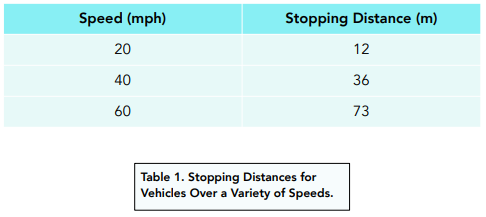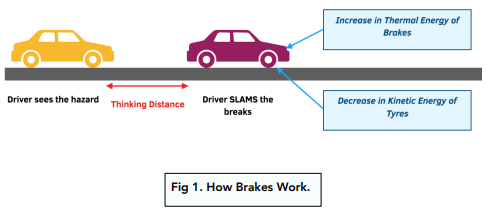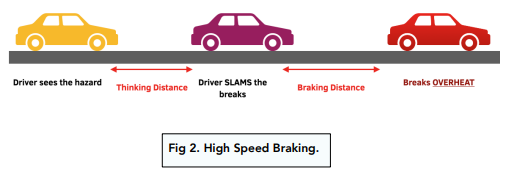Factors Affecting Braking Distance (GCSE Physics)
Factors Affecting Braking Distance
Adverse Conditions
- Adverse conditions can have a large effect on the stopping distance of a vehicle. Usually, they will lead to an increase in both the thinking and braking distances. Overall, these two will combine, resulting in a larger overall stopping distance in adverse conditions.
- Adverse conditions include wet or icy conditions, which will increase the stopping distance of a vehicle. The ice and rain on the road can lead to the car skidding, or ‘aquaplaning’. This can be very dangerous because the driver may lose control of the car, resulting in a car crash.
Vehicle Conditions
It is very important for the driver to keep their vehicle safe and functioning. Two things of particular importance are:
- Condition of Brakes – the driver of a car must keep their brakes in good condition. If the brakes aren’t in good condition, then the vehicle won’t stop quickly enough in an emergency.
- Condition of Tires – the driver of a car must keep their tyres in good condition. If the tyres aren’t in good condition, they can contribute to skidding in adverse weather conditions.
Emergency Stops and Safety
- Whether a driver is stopping in an emergency or not, they need to be able to stop safely. This means that they do not cause harm to themselves or others.
- We know that the faster a vehicle is travelling, the longer distance it takes to stop. This can be affected by a variety of factors, some of which we’ve already explored. These include alcohol, weather conditions and tiredness.
- The stopping distance of a vehicle can affect the safety of the driver. If a vehicle has a very large stopping distance, then the driver may have a difficult time stopping the vehicle before an accident occurs. This is why we have speed limits, so that drivers can stop safely when necessary.
Vehicle Stopping Distances
Different vehicles have different stopping distances. This is due to the size of the vehicle, the weight of the vehicle and even the grip on the tyres. For exams, you will need to know the stopping distances for vehicles over a variety of speeds.

How Brakes Work
In order to stop a vehicle from moving, a force must be applied to the brakes. This force is created by the driver pressing down on the brakes. As we have previously discussed, forces can result in work being done. This means that when the driver presses on the brakes, they are doing work. This has two effects:
- Reduces kinetic energy of tyres – as work is being done, the kinetic energy of the tyres will be reduced. As the kinetic energy decreases, the tyres will move less quickly. The kinetic energy from the tyres will be transferred into other forms of energy in the brakes.
- Increases temperature of brakes – some of the kinetic energy from the tyres will be transferred into thermal energy in the brakes. As the thermal energy of the brakes increases further, the brakes will get hotter. This means that the temperature of the brakes has increased.

Braking at High Speeds
Difficulty of Breaking at High Speed
- Speed makes braking difficult. When travelling at high speeds, it is difficult to brake over a small distance. We know that the higher the speed, the longer it takes for a vehicle to brake.
- Higher speeds require larger braking forces. When travelling at high speeds, vehicles will require a larger braking force to slow them down. Large forces will result in more work being done, so slowing down the car more quickly.

Large Decelerations
- Large braking forces lead to large decelerations. When a large braking force is used, the vehicle will slow down very rapidly. ’Slowing down’ is known as deceleration, and large braking forces will lead to large decelerations.
- Large decelerations affect the brakes. When a vehicle has a large deceleration, there is a significant effect on the brakes. In order to slow down the vehicle, a very large braking force is being applied, which will lead to lots of work being done. In turn, this work done will lead to lots of thermal energy in the brakes, potentially leading to them overheating.
Forces and Deceleration
In exams, you may be asked about the forces involved in a vehicle’s deceleration.
During deceleration, we know that the resistive forces will be greater than the driving force of the vehicle.
Therefore there is a resultant force going backwards. The car is still moving forwards, but is decelerating (remember resultant forces cause a change in speed).
You may be asked to estimate the size of these forces in an exam, such as the following example.
Question: A car travelling at average speed has to brake suddenly to avoid a child running into the road 15 metres away. Estimate the braking force involved in the car’s deceleration.
1. We know the average speed.
We know that the average speed of a car is about 30 m/s, from our table earlier on in this chapter.
Speed of car = ~ 30 m/s
2. We are assuming uniform deceleration.
Given this scenario, we need to assume that the deceleration is uniform to perform any kind of calculation.
3. We need to find the deceleration.
Now that we have a speed for the car, we can use our equation v² – u² = 2as. We need to rearrange this to find the deceleration.
v² – u² = 2as.
(v² – u²) / 2s = a
4. Substitute in the numbers.
(v² – u²)/ 2s = a
(30² – 0²) / 2 x 15 = a
900 / 30 = 30
a = 30 m/s²
5. Estimate the mass of the car.
Now that we have the deceleration of the car, we need to estimate the mass of the car.
Mass of a car = ~ 1200 kg
6. Use F = ma.
We have a mass and a deceleration, so now we can substitute in the numbers.
F = ma
F = 1200 x 30
Force = ~ 36 000 Newtons
FAQs
Braking distance is the distance a vehicle travels before it comes to a complete stop after the brakes are applied.
The following are some of the factors that affect braking distance: speed of the vehicle, road conditions, tire condition, weight of the vehicle, and the efficiency of the braking system.
The higher the speed of the vehicle, the longer the braking distance will be. This is because a faster moving vehicle requires more time and distance to come to a stop.
Road conditions such as rain, snow, ice, and gravel can increase the braking distance. These conditions can cause the tires to lose traction, making it harder for the vehicle to come to a stop.
Worn tires can decrease the traction of the vehicle, making it harder to come to a stop. Properly inflated tires with adequate tread depth will improve braking performance and decrease braking distance.
The heavier the vehicle, the longer the braking distance will be. This is because more force is required to stop a heavier vehicle.
The better the efficiency of the braking system, the shorter the braking distance will be. Modern vehicles have improved braking systems, such as anti-lock brakes, that can help reduce braking distance.
These questions and answers can help students understand the factors that affect braking distance and prepare them for their GCSE physics exams.





Still got a question? Leave a comment
Leave a comment